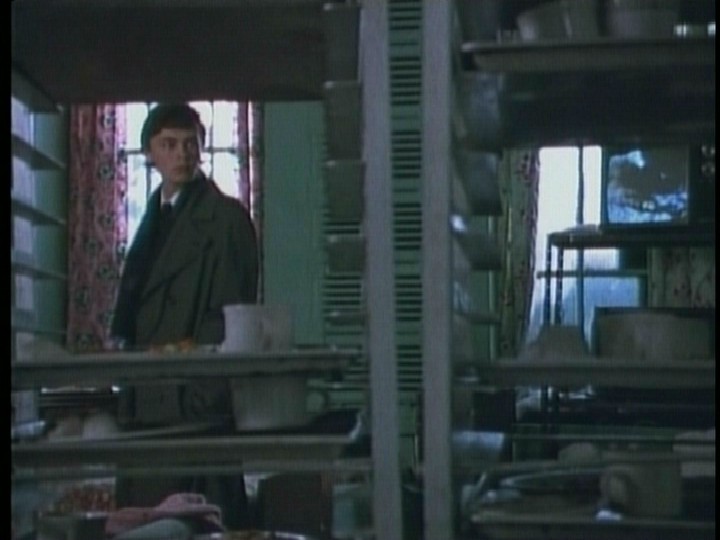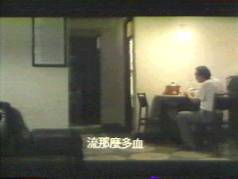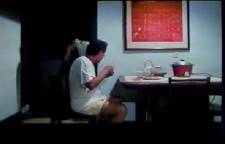The familial confinements in Family and Rebel are presented differently: through the use of the video camera in Family and through showing the physical constraints of the walls, ceiling and water in Rebel. Egoyan himself points out his use of three kinds of camera in Family: the video camera, the film camera and the video surveillance camera in the hotel and nursing home (Burnett 44). Thematically, the three kinds of camera match the three camera perspectives and the characters' three kinds of existence. The most constraining is the footage of the video surveillance camera, which is fixed at a spot above the characters and looking down. The camera shows within a TV frame black-and-white coarse-grained pictures of Aline in her phone-sex job or her being harassed by a client in a hotel. These pictures thus suggest her position of being exploited and controlled by patriarchal society. Without a TV frame, the constraint of the video camera footage of Van's family is less obvious than that of the surveillance camera. However, the sense of enclosure is still visually felt if we examine closely how the family scenes are videotaped, as Egoyan himself points out, "live in a television studio, using two video cameras and a switcher to edit the footage immediately on location" (Arroyo qtd in Shary 11). With limited camera angles, the video footage is quite a contrast to that of the mobile film camera assuming an objective omniscience. Moreover, the family scenes, with their bad sound quality and unnaturally white and flat setting, expose the sitcom-like artificiality of the family (Shary 9; Balley 46). To further expose its artificiality, Egoyan makes the beginning family video scenes rewind-able and its soundtrack mixed with the canned audience responses typical of TV sitcoms. In effect, then, Van's family life, which is dominated by the ritual of video-watching, is itself an unnaturally performed sit-com family romance. In this "home/video" shot in a confined space with limited cameras, moreover, he is confined by a reconfigured oedipal relation with his domineering father and his stepmother, who uses him to relieve her sense of boredom.
The domestic spaces in Tsai's films are small, bare, gloomy, confined by the walls, doors and ceiling that take up a large part of the screen. This sense of confinement is achieved through the camera's long-take from a fixed position. Instead of following the characters into their room, the camera frequently stays at a fixed spot, allowing the walls to block our view of the interior space of that room and to frame the characters' action in that space. Hsiao-kang in Rebel lives with his parents, while Ah-tze lives with a brother who seldom appears. Their domestic spaces are equally confining. Typically, the film shows Ah-tze's confinement through the elevator doors which close in on him, or through the water flooding from the stuck drainage in his kitchen. In Hsiao-kang's apartment (which appears in Rebel, The River and What Time is it There), the walls on the two sides of the narrow and short corridor are the most frequently seen settings in his family scenes. Functionally, this corridor connects all the other parts of the apartment (the two bedrooms, the kitchen and the dining-living room). However, the camera shows the family members coming in and out of the corridor space alone. In both Rebel and What Time is it There, the father speaks across the corridor to his son without getting any response. The only time we see the parents and the son together is when the parents discuss the possibility of Hsiao-kang's being the reincarnation of the Na-cha god, followed by Hsiao-kang's attempt at rebellion with his Na-cha dance.12 Framed by the corridor wall, Hsiao-kang's slim-bodied dance cannot really be wild. Gazed at by the parents, it is immediately suppressed by the father's throwing his bowl at him, just as the mother attempts to domesticate him with ashes of a charm.
|
|
The corridor scene in The River; father and son doing their own business. |
|
|
|
In challenging the traditional family structures, Egoyan and Tsai not only expose their spatial and patriarchal constraints, but also the meaninglessness of their family rituals. Eating, watching TV, video-taping are the family rituals that have lost their nourishing and unifying functions or change their meanings. Family mainly focuses on video watching: it shows how in Van's family TV dominates their life so much that they frequently watch TV and eat at the same time, with their eyes riveted on the TV screen. The opening scene in the nursing home, likewise, shows the dominance of a TV screen: with the food cart representing the limiting space of the nursing home, the film shows in between the narrow spaces of the food trays nothing but a TV set. "Family viewing," however, does not induce the sense of togetherness, nor does video-taping keep precious family memories. The film shows Van invitedto watch TV together with his "loving" parents but, in fact, in this typical living-room scene of family viewing, the son and the stepmother exchange amorous glances and kisses behind the father's back.

Van in grandmother's nursing home; Family Viewing.
Van's father seems to be "lovingly" recording a lot of family scenes; however, he changes the familial function of video-taping to satisfy his personal sexual desire. His shots of family scenes and sex scenes, moreover, do not convey any sense of togetherness; instead, they show the father always separate, detached and controlling. The first people to appear in his "family video" are Van's mother (who disappears later) and Van in his childhood, who are separated from the father both by the camcorder and the window. The intercourse scenes between the father and his second wife do not show any intimacy either; he is unable to have sex with his second wife without visualizing it through the video camera in front of them, or following the Aline's instructions in her sex-phone service for them. Later, it is even revealed in one video that he gags and binds up his first wife in an apparently intercourse scenario.
Eating in Rebel is not a nourishing family moment either as it is traditionally. The three family members, first of all, seldom eat together. Unlike the mother in The River, who feeds both her family and lover with leftovers from the restaurant, the mother in Rebel at least cooks. However, the fish she made, mixed with the ashes to domesticate Hsiao-kang, causes Hsiao-kang's diarrhea. To be nice to Hsiao-kang, the father in Rebel, like the father in The River, takes him to eat at food stands and even gives his own fruit to him. However, in neither film does Hsiao-kang enjoy the food, taking it passively or refusing to eat at all. (Only when he leaves home and stays in the empty apartment building in Vive l'amour can he enjoy his watermelon in his own ingenious ways.) Ah-tze's case is even worse: the food in his fridge seems to have all gone stale.
In this way, the traditional "signs" for the nuclear family and family rituals (e.g. Father, Mother, shelter, food, sex, and watching TV,) are all emptied of their traditional meanings by Egoyan in Family and Tsai in Rebel. To break away from this constraint and meaninglessness, the two male protagonists either create or search for a new family by joining a different space of flows--Van in the process of moving and substitution of videos and bodies, and Hsiao-kang in joining the space of flows that Ah-tze and his friends frequent. Van's discovery of the lost family videos initiates his rebellion against the patriarchal authority and re-construction of a new family. Both the rebellion and the family reconstruction are done through a series of replacements: Van replaces the videos of the family past with blank tapes to get hold of the former; he replaces the grandmother with Aline's dead mother to bury the latter's body in the former's name and to move the real grandmother out of the nursing home in the name of Aline's mother. This rescue of the grandmother, in turn, is done through a series of moves: from the nursing home to Aline's apartment, from her apartment to a hotel, and then from the hotel until the grandmother, as a homeless elderly woman, is moved to a women's hostel. Van's searching through different hostels as "un-homely places," finally and miraculously, brings him to his grandmother and his mother. In this way, the new "family" Van creates for himself includes not only his mother and grandmother, but also Aline and her mother. More importantly, this family is constructed after leaving the family space and in several "non-places." What Egoyan very skillfully shows in Van's rebellion is, then, that he cannot reunite with his biological mother and grandmother without submitting the latter to the process of moving and substitution--and thus revising the meaning of "family."
Although Van succeeds in leaving the constraining family space, the space of flows he experiences outside is not free from social and patriarchal control embodied in different camera eyes. What confines Van as well as his family, in other words, are not just the white and flat space of home, but also the different cameras eyes and the power they imply. It is important to note how the three kinds of camera intersect with each other in the film to expose the blurred boundaries between different kinds of viewing: surveillance, voyeurism, "family viewing" and pornographic visualization of secrecy. In the middle of the flows and intersection of the three kinds of camera footage is Van. Inside the home/video space, his discovery of the parents' secret ritual (of video-taping) is simultaneous with his finding the videotapes of his past family scenes; thus two kinds of
videotaping-- for sexual stimulation and family togetherness--become mixed together in the videos. When Van watches TV with his grandmother, the surveillance footage of Aline at work intersects with the TV program they watch; this seems to make Van ironically a viewer of both the predators in nature, of those in society (the sexual harasser), and then of the central symbol of power, the national flag, which concludes the TV programs. The sequence in which the film camera takes us across the screen to reveal Van's body switching is likewise ambiguous: apparently voyeuristic, the camera invites the viewers not to peep at beautiful bodies, but to get concerned with Van's act of rebellion and liberation. The father's means of surveillance, the detective's video camera, in the following hide-and-seek series, also serves multiple functions. The detective's camera, first of all, is powerful in recording Van and Aline's daily activities. However, the detective's "almighty" panning over the hotel building to search for Van is interrupted by the film camera's showing Van active in planning with Aline a way to rescue the grandmother by sending her away as a baglady. Instead of finding Van or the grandmother, the detective's surveillance video, ironically, finds the father collapsing in the empty hotel room after his failed search, thus denying the patriarchal power it seeks to support. As Van searches for his grandmother in a women's hostel, the searching film camera, ironically, finds a surveillance video first and then views from the latter's position Van's mother together with the grandmother. Also, juxtaposed with the surveillance camera is a past scene of the boy Van's screening his eyes to stare innocently at the father's video shot. The father's control may be now denied, but Van's new family is still not free from other more invisible forms of surveillance. What the film self-reflexively shows through the intersections of different camera perspectives, then, is that although power surveillance is inevitable, in the postmodern space of information flows different kinds of viewing and power relations are interchangeable and replaceable, which denies a stable meaning/power structure but allows new constructions of "family."
The flows of movements and traffic Hsiao-kang joins look more aimless than those in Family. Hsiao-kang is also engaged in a pursuit of self-identity and family; however, in Tsai's typically uneventful plot, his pursuit is far from being resolved in this film. From the envious gaze Hsiao-kang has at Ah-tze and Ah-gui on the motorcycle, we can tell that for Hsiao-kang they mean freedom. Indeed, Ah-tze, Ah-bing and Ah-gui are free from the pressure of the Joint Entrance Exam, and the spaces they frequent (playing or stealing in video game parlor, ice-skating palace and highway) involve constant movements in high speed. However, zooming through or staying in these non-places does not take them anywhere. In front of the video games, Ah-tze and Ah-bing sleep and play without any expression, looking more dead than alive. Stealing those IC cards gets Ah-bing beaten up by one store owner's gang. After drinking and "flying like a bird" on a highway, they end up vomiting at one side of a mass transit railway construction site or lying on the ground on the other side. The metal fence in between them shows the spiritual dead end they are constantly in. It is this spiritual poverty that drives Ah-tze from the hotel to play aimlessly in the video game arcade; also, the same kind of dead end symbolically blocks the drainage in his kitchen and turns the flows inward to invade his domestic space.
Hsiao-kang's motivation in joining the other youngsters' spaces is not clear. Vaguely he wants rebellion and power, but he cannot do it to either his parents or a cockroach. Refusing to stay in the cram school, he picks up and identifies with "empty" signs of rebellion: an air gun, a picture of James Dean, and the other three youngsters. But does he follow them to seek revenge against Ah-tze, who smashes up his father's rear window, or to make friends with the latter? Maybe both. Neither attempt, however, gets him anywhere: after messing up Ah-tze's motorcycle he goes home only to be locked outside by his father; he jumps up and down (to be like the Na-cha god) at seeing the dismayed Ah-tze only to be hit by the ceiling; he follows Ah-tze again to offer help only to be rejected.
The spaces of flows presented in this film thus seem either stagnant or aimless, which is reinforced by the repetitive, tuneless and low-key background electronic music resembling the music of some video games tuned lower. However, we should not ignore the values of the characters' self-reflexive acts: drifting away from the traditional family and the fixed route of the Joint Entrance Exam teenagers usually take in Taiwan, they design their own codes of honor and they follow their own principles in their drifting. Ah-tze and Ah-bing, for one thing, follow their own codes of brotherhood and justice. Although they are not real brothers, Ah-tze and Ah-bing help each other when needed. Although they talk about Ah-gui as a gal to hook up with, they do not violate Ah-gui when she is completely drunk and unconscious. As for Ah-gui, she is generous in offering her bodily warmth to the seriously wounded Ah-bing, and, though not knowing how, she wants to break away from their aimless life. Even the father, as a taxi-driver, takes the two young men home, instead of leaving the bleeding Ah-bing lying on the road. To his own son, the father is of course more caring: toward the end of the film, he leaves the apartment door open to let Hsiao-kang in.
Is Hsiao-kang, then, a wandering ghost drifting aimlessly from one non-place to the next? It is Tsai's style to leave his ending open, and to show Hsiao-kang making progress very slowly from one film to the next. Still, in this film Hsiao-kang is not just a passive, un-self-reflexive receiver of the flows of signs and desires. For one thing, his refusal to stay in the cram school is courageous, and he is active in searching. Although he does not know yet what he wants specifically, he actively assumes the identity of the Na-Cha god twice to express himself, and, most importantly, he refuses to wait passively for the phone to ring in the telephone friend-making center. He may join the completely aimless and indifferent flows of traffic at the end of the film, but, considering the choices he has made actively, he will not, at least not always, drift passively with the flows.
